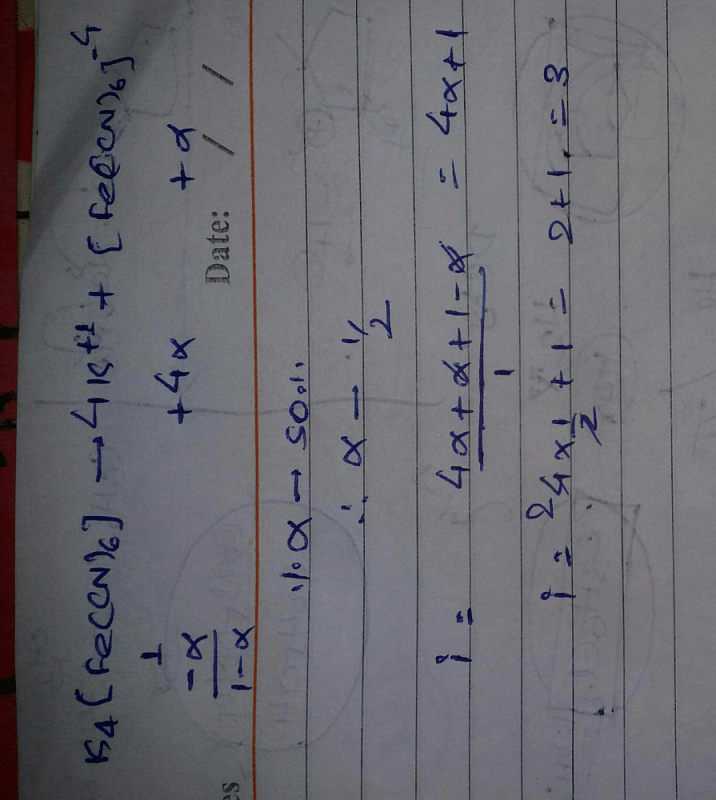Class 12 Exam > Class 12 Questions > A decimolar solution of potassium ferrocyanid...
Start Learning for Free
A decimolar solution of potassium ferrocyanide K4[Fe(CN)6] is 50% dissociated at 300K. Calculate the value of van't Hoff factor for potassium ferrocyanide.?
Most Upvoted Answer
A decimolar solution of potassium ferrocyanide K4[Fe(CN)6] is 50% diss...

Community Answer
A decimolar solution of potassium ferrocyanide K4[Fe(CN)6] is 50% diss...
Calculation of van't Hoff factor for potassium ferrocyanide
Step 1: Understanding van't Hoff factor
Van't Hoff factor (i) is defined as the ratio of the observed colligative property to the calculated colligative property. It is a measure of the degree of dissociation of a solute in a solution.
Step 2: Calculation of degree of dissociation
Given, a decimolar solution of potassium ferrocyanide K4[Fe(CN)6] is 50% dissociated at 300K.
Degree of dissociation (α) = 50/100 = 0.5
Step 3: Calculation of van't Hoff factor
The formula to calculate van't Hoff factor is:
i = 1 + α(n-1)
where n is the number of particles into which the solute dissociates.
Potassium ferrocyanide dissociates into four ions in solution: K+ and Fe(CN)6-4, each of which carries a charge of 1, and two CN- ions, each of which carries a charge of -1.
Therefore, n = 4
Substituting the values in the formula, we get:
i = 1 + 0.5(4-1) = 2.5
Therefore, the van't Hoff factor for potassium ferrocyanide is 2.5.
Step 4: Interpretation of result
The van't Hoff factor of 2.5 indicates that potassium ferrocyanide undergoes significant dissociation in solution. This is because the number of particles into which it dissociates is higher than the number of particles in a non-dissociating solute. The value of 2.5 is also consistent with the fact that potassium ferrocyanide is an electrolyte and therefore dissociates in solution.

|
Explore Courses for Class 12 exam
|

|
Similar Class 12 Doubts
A decimolar solution of potassium ferrocyanide K4[Fe(CN)6] is 50% dissociated at 300K. Calculate the value of van't Hoff factor for potassium ferrocyanide.?
Question Description
A decimolar solution of potassium ferrocyanide K4[Fe(CN)6] is 50% dissociated at 300K. Calculate the value of van't Hoff factor for potassium ferrocyanide.? for Class 12 2024 is part of Class 12 preparation. The Question and answers have been prepared according to the Class 12 exam syllabus. Information about A decimolar solution of potassium ferrocyanide K4[Fe(CN)6] is 50% dissociated at 300K. Calculate the value of van't Hoff factor for potassium ferrocyanide.? covers all topics & solutions for Class 12 2024 Exam. Find important definitions, questions, meanings, examples, exercises and tests below for A decimolar solution of potassium ferrocyanide K4[Fe(CN)6] is 50% dissociated at 300K. Calculate the value of van't Hoff factor for potassium ferrocyanide.?.
A decimolar solution of potassium ferrocyanide K4[Fe(CN)6] is 50% dissociated at 300K. Calculate the value of van't Hoff factor for potassium ferrocyanide.? for Class 12 2024 is part of Class 12 preparation. The Question and answers have been prepared according to the Class 12 exam syllabus. Information about A decimolar solution of potassium ferrocyanide K4[Fe(CN)6] is 50% dissociated at 300K. Calculate the value of van't Hoff factor for potassium ferrocyanide.? covers all topics & solutions for Class 12 2024 Exam. Find important definitions, questions, meanings, examples, exercises and tests below for A decimolar solution of potassium ferrocyanide K4[Fe(CN)6] is 50% dissociated at 300K. Calculate the value of van't Hoff factor for potassium ferrocyanide.?.
Solutions for A decimolar solution of potassium ferrocyanide K4[Fe(CN)6] is 50% dissociated at 300K. Calculate the value of van't Hoff factor for potassium ferrocyanide.? in English & in Hindi are available as part of our courses for Class 12.
Download more important topics, notes, lectures and mock test series for Class 12 Exam by signing up for free.
Here you can find the meaning of A decimolar solution of potassium ferrocyanide K4[Fe(CN)6] is 50% dissociated at 300K. Calculate the value of van't Hoff factor for potassium ferrocyanide.? defined & explained in the simplest way possible. Besides giving the explanation of
A decimolar solution of potassium ferrocyanide K4[Fe(CN)6] is 50% dissociated at 300K. Calculate the value of van't Hoff factor for potassium ferrocyanide.?, a detailed solution for A decimolar solution of potassium ferrocyanide K4[Fe(CN)6] is 50% dissociated at 300K. Calculate the value of van't Hoff factor for potassium ferrocyanide.? has been provided alongside types of A decimolar solution of potassium ferrocyanide K4[Fe(CN)6] is 50% dissociated at 300K. Calculate the value of van't Hoff factor for potassium ferrocyanide.? theory, EduRev gives you an
ample number of questions to practice A decimolar solution of potassium ferrocyanide K4[Fe(CN)6] is 50% dissociated at 300K. Calculate the value of van't Hoff factor for potassium ferrocyanide.? tests, examples and also practice Class 12 tests.

|
Explore Courses for Class 12 exam
|

|
Signup for Free!
Signup to see your scores go up within 7 days! Learn & Practice with 1000+ FREE Notes, Videos & Tests.



















